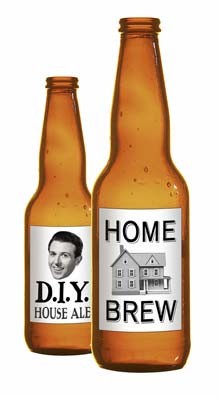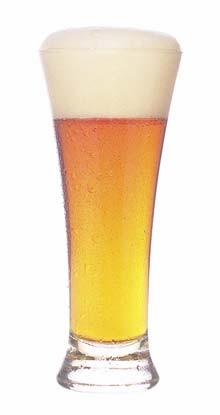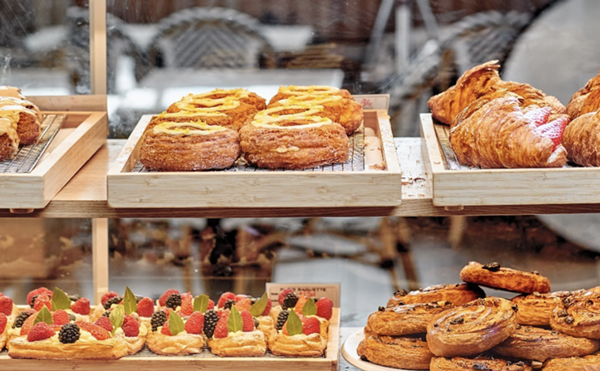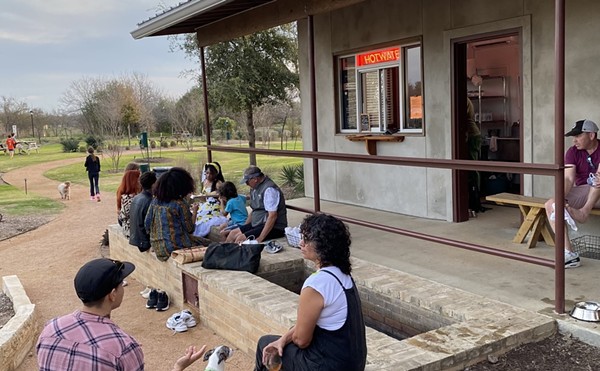A fine homebrew is equal parts chemistry and philosophy
According to Todd Huntress, there are two ways to approach homebrewing beer: either you work in exact weights and measures, calculating recipes like a scientist, or you follow your instincts, like a chef. "They can both be pretty intense," he says, "but I fall more in the second group.
I know what's supposed to go into the beer, so I just work in small steps 'til I get it the way I want it."
| New glass beer bottles can be expensive, so Huntress recommends rescuing, sanitizing, and recapping used beer bottles. Make sure they are crown caps, as twist-offs may not seal properly when you apply your own crown caps. |
Huntress' storefront, San Antonio Homebrew Supply & Bar on North St. Mary's, is as unkempt and homey as a laboratory is sterile. On one side, well-stocked shelves provide everything necessary for brewing, from bins of barley grain and raw coffee beans to five-gallon glass carboys, Cooper's carbonation drops, and hefty cans of wine-fruit. On the other side, behind a long wooden bar, a chalkboard advertises five beers, ranging from a hoppy Sierra Nevada Summerfest lager to a creamy Smithwick's ale. A lightwell casts a square of hazy sunlight across an oak wine barrel, its mottled tabletop strewn with empties - Lapin Kulta, Oerbier, and Oettinger - and burned-out candles. There's an old fridge for yeast and a few outlying Frisbee-golf baskets.
Here locals gather to drink beer on tap and homebrew clubs meet to share their beers and shoot the shit about cooking, roasting coffee, gardening, and whatever else they might be up to. "Homebrewing really fosters that community," says Huntress. "Those who brew a lot tend to like to share a lot. And there really is a make-it-yourself kind of attitude."
Homebrew is made by boiling water, malted barley, and hops - dried flowers - to form a wort, or unfermented beer. The wort, which is very starchy, is transferred into a fermentor, or a glass carboy bottle, and yeast is added. As the beer ferments, the starches convert to sugar. The yeast eats the sugar and creates carbon dioxide and alcohol. This process, which can take a week or two, is called zymurgy.
"It's pretty simple," Huntress says. But it's simple like chess: The more you know, the more complex it gets.
Homebrew gets color, body, and flavor, discernable to a trained palate, from the malted barley. Lightly toasted malt creates a light beer and, conversely, a dark malt will create a heavier, darker beer. Hops thrown into the wort at the beginning of the boil, which lasts an hour, affect the bittering of the beer. Hops added after 40 minutes affect flavor; in the last minute, aroma. Yeast can add flavor, too, and there are hundreds of varieties of ale, lager, and wheat yeasts.
As with all hobbies, there are levels of involvement. Hardcore homebrewers mash their own barley malt, but beginners can also brew a satisfying beer from a canned kit, avoiding complexities. One thing that can't be avoided, though, is boiling all of the ingredients and thoroughly sanitizing the equipment. "Unfermented beer is so sweet, it's the perfect place for micro-organisms to grow," Huntress explains. "You want the good yeast to grow as fast as possible, so it crowds out the bacterial infections because that's what'll mess up your beer, other than light."
There is an oft-repeated saying in the leaves of Charlie Papazian's the New Complete Joy of Home Brewing, the home-brewers bible: "Relax. Don't worry. Have a homebrew." It means that even while you may linger over the wort, waiting for the right moment to drop in the hops, you should not rush or fret, for a negative vibe can spoil the beer as surely as bacteria, and feeling is as important as formula.
"Todd really represents that whole philosophy," says Scott Martin, who started homebrewing as a 12-year-old for a zymurgy science project. "If you meet him you can just see it, and if you don't see it there's something wrong. He's our teacher, really, and I think he does exceptionally well in that mentor role."
Martin is a lager brewer. Basically, all beers are lagers æ pilsners, bochs, dunkles æ or ales æ ambers, browns, stouts, and porters. Lagers are typically fermented in the low 40s, which requires a dedicated refrigerator, while ales ferment in the high 60s, or cool room temperature ("I brew mostly ales," says Huntress, "because lagers are pretty tedious.").
Once a beer is fermented, it needs to reach carbonation in the bottle, which takes about a month. But you don't have to drink it then: Unlike commercial beer, homebrew can be drunk for up to five years after it's brewed, and may even improve with age. Martin served me a Kolsch he brewed from pilsner malt and Czech and German hops in February 2000. When I got to his house, it was still in the pantry, too warm to drink. I suggested the freezer. "Oh no," he said. "Homebrew is not something to force. Don't shake it, just put it upright in the fridge."
A couple of hours later, it was ready. A clear, light yellow beer, it opened with a resounding pop and had a good head and a deliciously bitter, hoppy flavor. Martin poured the dregs of the beer, murky with yeast, into a shot glass. It tasted smooth and sweet. "Usually, the brewer drinks the sediment. It's really good for you, mostly vitamin B, and it'll keep you from getting a hangover," he said.
Back at SA Homebrew, I sample a couple more beers, trying to pick out the hops from the yeast flavors. Huntress sets up a small glass of hefeweizen, made from a wheat yeast that tastes of bananas and clover. Next, he pours a Sierra Nevada pale ale that has a sweet apple flavor from yeast, and a citrus hops finish. It's good but I can't help noticing it's a little warm. In the dog days of summer, Huntress explains, you may crave an icy beer, but it's tastiest served cool, not cold. That said, warmth accelerates bacteria growth, so ideally beer is aged cold. "Most bars serve beer a little too cold," he says. "My advice to consumers is to let it sit for 10 minutes. I know homebrewers who will microwave it for 10 seconds."
It's Saturday afternoon. All the bar stools are taken and Huntress is playing guitar along to Glen Campbell's "Gentle on my Mind." "Of course," he adds, shaking his head, "if you let an American-style beer sit 10 minutes, it'll be pretty undrinkable. But it's hard to make those beers anyway. I always have to tell people it's almost impossible to brew a crisp, clean Budweiser. Hoppier beers just come out better." •
By Susan Pagani



















